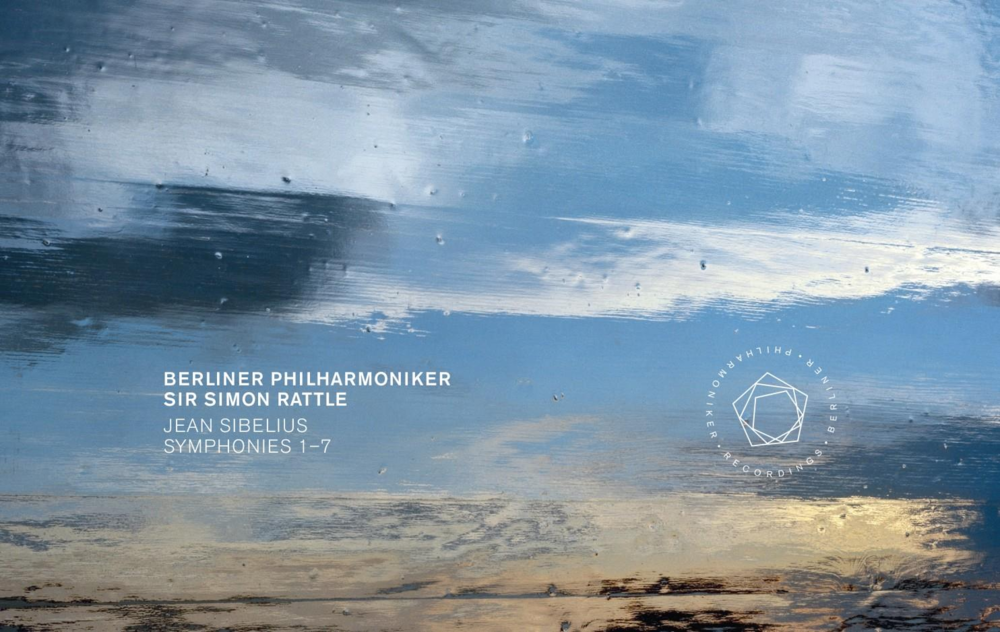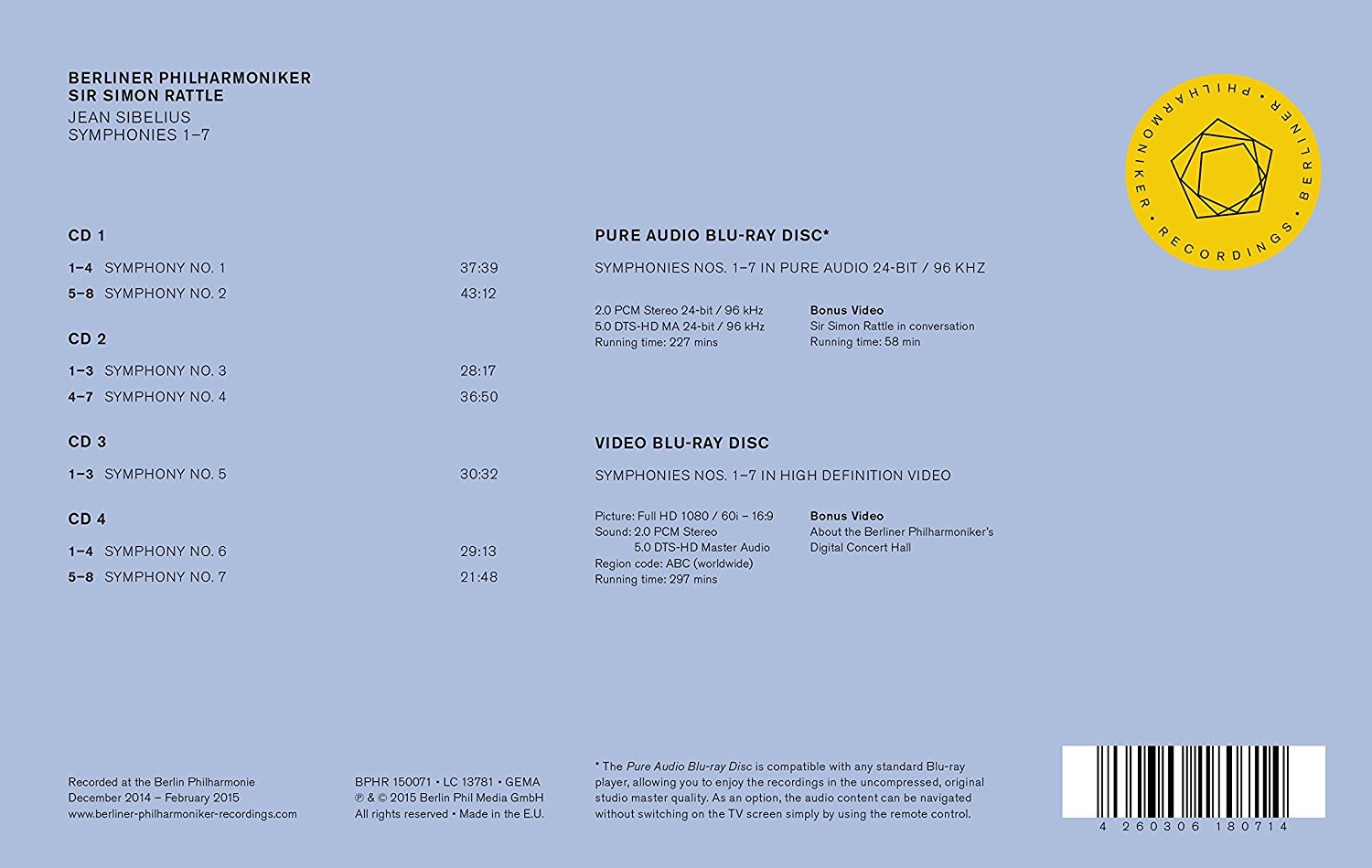

Sibelius Symphonies 1-7 (or Complete Sibelius Symphonies) box set. Sir Simon Rattle conducts the Berliner Philharmoniker in all seven Sibelius symphonies. This review, by Wonk Bryan Balmer, applies only to the Blu-ray video and not to the CDs or Blu-ray audio disc included in the box. Grade: C (average for the 7 symphonies).
The box contains:
4 CD’s (i.e. PCM 44.1kHz/16-bit)
1 Pure Audio Blu-ray Disc (audio is listed on the box as 96kHz/24-bit – in both 2.0 PCM Stereo and 5.0 dts-HD MA)
1 Video Blu-ray Disc (audio is listed on the box as 48 kHz/16 bit – in both 2.0 PCM Stereo and 5.0 dts-HD MA; however, my system indicates the audio tracks as 48kHz/24- bit – in 2.0 and 5.1)
Download code for obtaining high-resolution audio files (up to 192kHz/24-bit FLAC files)
7-day ticket for Berliner Philharmoniker’s Digital Concert Hall
64 page booklet (in English and German) with track listings, brief notes on each symphony, 2 articles, a listing of orchestra musicians, and production details and credits
The video directors vary among the titles as follows:
Symphonies Nos. 1 & 2 – directed by Daniel Finkernagel and Alexander Lück
Symphonies Nos. 3 & 4 – directed by Michael Beyer
Symphonies Nos. 5, 6 & 7 – directed by Robert Gummlich
The recording location was the Philharmonie Berlin. The Berliner Philharmoniker’s archive concert listings indicate that these works were performed on the following dates:
5 February 2015 (Symphonies Nos. 1 & 2)
28-29 January 2015, 6 February 2015 (Symphonies Nos. 3 & 4)fwork
18-20 December 2014, 7 February 2015 (Symphony No. 5)
7 February 2015 (Symphonies Nos. 6 & 7)
The 150th anniversary of Sibelius’s birth in 2015 resulted in an expanded selection of high-resolution videos of his works. In particular, the Lintu Sibelius Symphonies box (reviewed earlier this year on this site) re-opened my ears to the charms to be found in his music.
I find myself almost equally drawn to all 7 symphonies—there is not a dud in the crowd! They are approachable, tuneful, and emotionally involving without being saccharine. There is solid thematic development for the brain to follow, yet plenty to tempt a listener (namely, me!) to engage in heat-of-the-moment “arm-flapping” (home conducting) as I’m carried off by the music to a far-away place. This music, especially when accompanied by a concert video, inevitably provides me with a very satisfactory sensory experience!
Rattle’s musical interpretations with the Berliner Philharmoniker have been growing on me. The orchestra members are all so solid; their confidence and musicianship emanate brightly. I was fascinated throughout by the incredible unison of the strings, the warmth of the brass, and animated sparks from the woodwinds. You can see from the screenshots later in this review how brilliant the PQ is, and the SQ is also outstanding.
But as we have seen in many recently published symphony Blu-rays, there is a serious video content problem with the video recordings in this box. There is a special feature on the Blu-ray video disc that describes the extent of planning undertaken for the video production, including bar-by-bar analysis of the score. A lot of work went into making the videos. But the producers’ goals were faulty and out-of-date.
Even though the producers apparently never planned to publish the Sibelius recordings in DVD, they in fact diligently prepared DVD-style videos. It seems they were not aware that symphony videos for Blu-ray (or HDVD) presentation need to be made in a radically different manner (from DVDs) that takes advantage of the capabilities of HD video cameras. They forgot that a good DVD can't be a good HDVD, and a good HDVD can't be a good DVD. Because the videos were not correctly made, they suffer from what we call DVDitis.
For a thorough explanation of all this, see our special article Standards for Grading Symphony Orchestra Concerts of Symphonies, Concertos, and other Large-scale Compositions. After working your way through that article and some of the many reviews on this site discussing DVDitis, you will understand the following mantra:
“A good HDVD should have a slow pace with more than 10 seconds per video clip on average (longer the better). 20 to 40% (higher is better) of the clips should be large-scale "supershots." Conductor shots should be less than 20% (way less really) of the clips in the video.”
And how do you know whether a particular video is an HDVD by virtue of a slow pace, a large number of supershots, and small number of condutor shots? Well, you grab a Wonk Worksheet, step your way through each clip in the recording, fill out the worksheet, and run the numbers. Then you can tell if your Blu-ray symphony recording is dead on arrival from DVDitis or is a modern and up-to-date HDVD. Click here to see a worksheet of Sibelius Symphony No. 3 played by the Berliner Philharmoniker and recorded by Michael Beyer.
I ran the numbers on 6 of the 7 symphonies in the Sibelius box. I graded each symphony. In accordance with HDVDarts.com protocol for grading Blu-ray concert performances, I started with an A+ grade. A partial grade deduction is applied for non-96/24 audio, bringing us to an A. Video throughout the set has good clarity (16:9, 1080/60i) and reasonably few errors (i.e. out-of-focus), so no further deduction is necessary for PQ. I then deducted a letter grade for each of the 3 tests in our mantra that a title flunks.
Following these rules, I prepared statistics for two titles from each of the three video directors, and here are the results:
|
Symphony |
1 |
2 |
3 |
4 |
5 |
7 |
|
Pace (s/clip) |
7.4 s |
7.2 s |
6.6 s |
7.8 s |
7.1 s |
6.9 s |
|
Supershots |
23 % |
25 % |
11 % |
6.6 % |
21 % |
32 % |
|
Conductor Shots |
28 % |
25 % |
23 % |
22 % |
21 % |
19 % |
|
Grade |
C |
C |
D |
D |
C |
B |
|
Comments |
Panning and zooming with some focus issues |
Many IO (11/18) and poorly framed shots |
Only 1 IO shot between both symphonies |
|||
|
Director(s) |
Finkernagel and Lück |
Beyer |
Gummlich |
|||
Let's see in more detail how I graded Symphony No. 3. The pace of 6.6 seconds per clip is almost twice as fast as the minimum pace for an HDVD. So S3 flunks the pace test---it's way too fast-paced for comfortable viewing in a modern HT. Supershots are only 11%. The vast majority of the video is geared for DVD consumption, and only 11% of the video takes advantage of the HD cameras. So S3 flunks the supershot test. Almost a quarter of the clips in the video just show Rattle, which is a hallmark of the DVD. So this S3 flunks the conductor test also. Since this video is a three-time loser, it drops 3 grades: from A to D. Finally, I blended all the grades for the 7 symphonies into a C grade for the entire box.
Now let's consider some screenshots taken at random from the 7 recordings. I personally enjoy watching the conductor. Others think watching the conductor is a waste of time. I'll say that Rattle is especially interesting to watch, as you can see in the first 3 screenshots below. If you are conductorphobic, be aware that Rattle appears on average about twice in each minute of these Sibelius videos:
Everyone will agree that the next shot below is an excellent whole-orchestra ("WO") view. It allows you to see where all the orchestra sections are located and even to count the instruments in most sections. These are the kinds of HDVD shots that HD cameras can make, but which usually are not often feasible when making a DVD. Unfortunately, we don't see many shots like this in subject Sibelius box. For example, in video of Symphony No. 3, there are only 6 WO clips:
The next screenshot below is a typical part-orchestra view. Alas, we also get few of these shots in subject title. Check our WW for Symphony No. 3 and you will see that that video only had 9 part-orchestra views:
Next below is a gorgeous shot of all the violins followed by 3 pretty shots of multiple sections. All the views of the orchestra so far prove that it was in 2015 possible to make a splendid HDVD of symphony concert in the Berliner Philharmonie building. As further proof of this, note that NHK made in 2008 an A+ symphony video in this same building with this same orchestra. After that, many symphony videos were made in this venue for the DVD market and were then also sold as Blu-ray titles (with bad cases of DVDitis). I can understand why it might have been prudent for business reasons to make these DVD titles. But there is no DVD box set for the Sibelius symphonies. If there was no need to make DVD-style videos, why did the Berliner Philharmoniker not make Sibelius videos that would take full advantage of HD technology?
In the table above I mentioned "poorly-framed" shots in the videos of symphonies 3 and 4. Below are 2 random examples of poor framing. The closer the camera gets to the subject, the harder it is to avoid inane results. And the faster the pace, the less time the cameramen have to properly set up their shots and correct problems before it's time to start shooting. Slowing the pace and making large-scale shots with the HD cameras would make life easier for the video technicians at every stage in the recording chain. And it would make for a more relaxed and pleasant viewing experience for the HT audience.
I have recently finished reviewing 14 videos of Sibelius symphonies in competing box sets: one by the Finnish Radio Symphony Orchestra with Lintu conducting and subject title by the Berliner Philharmoniker under Rattle. Both orchestras performed magnificently. Both boxes are enjoyable. But I wind up with a blended grade of B for the Finns and C for the Berliners.
Because of DVDitis, neither Sibelius box accomplishes the mission for record customers who have home theaters with modern TVs. The Finns had the excuse that they planned to sell primarily to the DVD market, and the Blu-ray box was for them a secondary effort. But the Berliners are attempting to sell to the elite Blu-ray market, in luxury packaging, a product that is, well, obsolete. What a mystery.
4K is coming soon! The way is wide open for someone out there to produce a Sibelius Symphony box that today's customers can welcome and cherish. In the meantime, the Lintu box is the better bet if all you want is Blu-ray video. If you are also interested in CDs and/or Blu-ray audio music, then the Berlin box could be the better choice.










